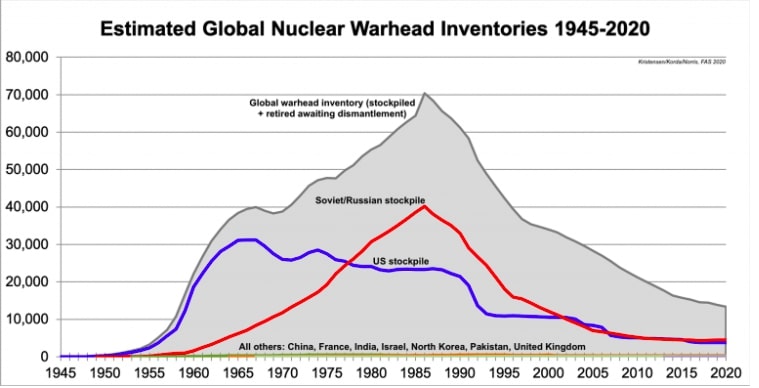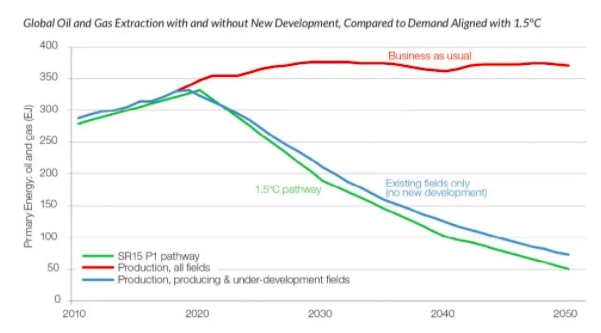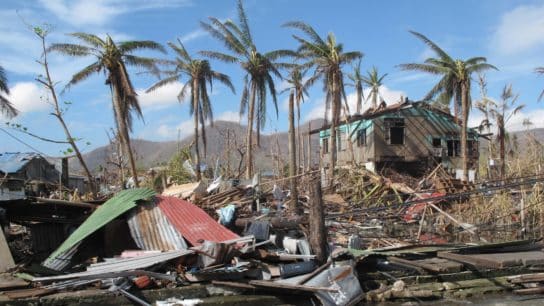In 1968, the Treaty for The Non-Proliferation of Nuclear Weapons (NPT) was signed. This was a multilateral treaty aimed at reducing the volume and spread of nuclear weapons in the world. The NPT is considered to be a landmark international agreement, and was extended indefinitely in 1995. The treaty emerged from a growing concern for the state of the world were it to contain too many nuclear weapons and states with nuclear capabilities. The NPT helped shift the conversation around nuclear weapons from them being a regrettable but necessary evil, to being an existential risk and security concern for all mankind. In 2020, a multinational team of experts began discussing drafting a similar non-proliferation treaty for fossil fuel use, categorising the risk of burning hydrocarbons as akin to that of possessing nuclear weapons. Regardless of the political implications of such a treaty, it is an important step towards changing the way we talk about fossil fuels to better reflect the dangers of their continued use.
—
Nuclear weapons and fossil fuels pose existential risks for humanity in their own ways, which is why a non-proliferation treaty concerning fossil fuels is beginning to gain traction worldwide. There is simply no need anymore for countries to continue prioritising fossil fuels in their energy mix, much like a general consensus eventually emerged during the Cold War that the potential harm of nuclear weapons vastly outweighed benefits.
In the early days of the Cold War, nuclear weapons were considered the cornerstone of a mutual deterrence policy between the US and the USSR. The possibility of retaliation restrained both actors from dipping into their nuclear arsenal. This perspective changed, however, when the two superpowers understood that the relationship between them was exceedingly fragile, and could spiral out of control at any moment. Both countries had their nuclear warheads on a ‘hair-trigger alert,’ able to deploy within minutes of receiving an order. When catastrophic launches almost happened due to false alarms or faulty sensors, it became clear that nuclear weapons were an existential risk, and that they had to be scaled down by a tremendous margin to avoid having them become fixtures in the military arsenals of more countries.
While the NPT has received criticism over its voluntary nature and lack of policing power over signatories, the treaty has played an important role in changing the language around nuclear weapons, and reducing the global stockpile of nuclear weapons to a fifth of what it was during the peak of the global arms race in the 1980s and 90s.
You might also like: Why Isn’t Russia Ramping Up its Use of Renewable Energy?

Figure 1: Variations of global, Soviet/Russian and US stockpile of nuclear arms; Federation of American Scientists; 2020.
While the threat of global nuclear annihilation has decreased in the modern age, fossil fuels are another technology that we have largely outgrown, and as the leading cause behind global emissions and climate change, pose a dangerous existential risk to long-term survivability on Earth. While fossil fuels are still expected to be a part of the global energy mix for the foreseeable future, there is no need for countries, especially wealthy ones, to continue expanding their fossil fuel sector.
A fossil fuel non-proliferation treaty would seek to address this. Modelled on the NPT, this new treaty creates a framework for countries to follow and end their fossil fuel production before transitioning fully towards renewables. By reframing the conversation and employing effective rhetoric to highlight the existential risks of continued fossil fuel use, advocates hope that such a treaty would drive a ‘disarmament’ of the fossil fuel industry.
Terms of The Treaty
Steered by an international team of climatologists, activists, entrepreneurs and politicians, the Fossil Fuel Non-Proliferation Treaty was launched in September 2020, and has since been actively advocating for organisations and governments to adopt its fossil fuel disarmament goals. One of the crafters of the initiative and president of the Center for International Environmental Law, Carroll Muffett, discussed the treaty’s mandate as such: “there are certain technologies and certain substances that pose such a global risk to humanity that we have an obligation to address that risk together.”
In October 2020, Vancouver became the first city to fully endorse the treaty, while Barcelona endorsed it in January 2021 and New York City and Los Angeles are both moving towards endorsement. The initiative has also garnered endorsements from over 100 organisations and institutions and over 7 000 high-profile individuals, including noted Canadian environmental activist and author Naomi Klein and former President of Ireland Mary Robinson.

Figure 2: Temperature rise pathways with and without new development of fossil fuels. Eliminating new development of fossil fuels would place us within striking distance of the Paris Agreement’s 1.5°C goal; Fossil Fuel Non-Proliferation Treaty; 2020.
The Fossil Fuel Non-Proliferation Treaty’s mission is to help achieve the Paris Agreement’s targets of keeping global temperature rise below 1.5°C. Its goals are similarly modelled on the NTP’s three primary outcomes: nonproliferation, disarmament and the ‘peaceful’ development of new energy technologies. The Fossil Fuel Non-Proliferation Treaty calls for the same goals, but interprets them in different ways:
Nonproliferation means ending production of fossil fuels. All proposals for further extraction and production of fossil fuels need to cease immediately. Since the fossil fuel sector is already the largest contributor to global emissions, any planned expansion of the sector needs to be halted immediately.
Disarmament means phasing out current stockpiles and power plants. This means more active government intervention by removing fossil fuel subsidies, actively limiting extraction activities and regulating fossil fuel supply through market mechanisms such as carbon pricing.
Peaceful development refers to a transition towards renewables. This last goal is based on the idea of a just transition, involving worker reskilling, investments towards education and green job creation. The framework offered by the treaty highlights the economic benefits of a more diversified and agile labour force in an energy market focused on renewables rather than fossil fuels.
To promote accountability and transparency, the initiative is also creating a Global Registry of Fossil Fuels, which will function as a public-access database with information on fossil fuel production and reserves. The registry aims to catalogue all known fossil fuel resources, what plans exist to extract them and how these practices align with the larger goal of keeping temperature rise below 1.5°C. The treaty would make extraction practices more transparent and hold producers accountable by publicising their actions to governments, financial institutions, investors and other decision-makers.
Such a registry is crucial to the treaty’s success. An assessment of existing reserves and a framework of monitoring and compliance among businesses and investors is critical to building public trust and legitimising the treaty’s role. Two of the treaty’s architects, Peter Newell and Andrew Simms, authored a study in 2019 on the potential impact of a fossil fuel non-proliferation treaty. The study emphasises how a fully realised treaty will appeal to countries most vulnerable to climate change as well as wealthy countries who may be actively working to reduce their own supply of fossil fuels. The authors posit that a multilateral framework such as a treaty would provide more assurances for wealthy nations that their rivals are indeed also decarbonising. Without such a framework, nations competing with each other may not be incentivised to pursue meaningful change due to concerns that other countries would not do the same and outpace them economically.
‘A Slow-Moving Weapon of Mass Destruction’
There are multiple ways to frame climate change and its impacts. Some commenters tend to be more alarmist, apocalyptic and accusatory. Others can be more solutions-oriented, reconciliatory and agreeable. Both approaches have their upsides, but what all communicative tactics on climate change need to have, and something that governments and decision-makers are starting to see the value of, is appropriately weighted language when discussing the risks that climate change pose.
Language is an oft-overlooked but critically functional tool in the fight against climate change. The way it is framed in our media and government communications shapes public discourse and opinion. If climate change is not discussed as the great disruptor of economies, politics and lifestyles that it is, many will not consider it anything to be greatly concerned about.
Climate alarmism certainly has its shortfalls, but there must be a middle ground between the barren-Earth visions of the future sometimes pushed by activists and absolute climate denialism.
Comparing fossil fuels to nuclear weapons may just be that middle ground. Climate change and nuclear warfare are existential threats, and while neither may threaten the absolute extinction of humanity, both have the capacity to fundamentally change our way of life and perhaps even cripple civilisation to the point of being unrecoverable.
Talking about technologies as weapons raises the stakes of their use by making them sound dangerous, and that rhetoric can shape public opinion. Surveys in the US on the validity of using nuclear arms in warfare illustrate how public perception towards a contentious topic can change over time. In 1951, 67% of respondents believed that nuclear bombs would be a justified first strike against the Soviet Union. In 2002, 71% of respondents opposed the strategic use of nuclear weapons in the War on Terror, with 22% stating that they should never be used at all.
The NPT may not have been directly responsible for the change in opinion, but the shift in official rhetoric towards nuclear arms certainly played a part. For most of the Cold War, nuclear weapons had been accepted because of the deterrence factor and security benefits of possessing them, so publicly discussing them in terms of the existential risks they carried for all life on Earth was a drastic change in rhetoric. Highlighting these existential consequences of nuclear warfare prompted a measurable change in public opinion towards nuclear weapons.
A similar shift in the discussion surrounding fossil fuels could have the same effect. “They’re framing climate change as sort of a slow moving weapon of mass destruction. That kind of reframing can be very powerful,” says Charli Carpenter, a professor of political science at the University of Massachusetts-Amherst, on the treaty’s rhetoric. “We sort of think of climate change as an environmental issue, but it’s really more like a slow motion asteroid headed towards the planet.”

Figure 3: Global fossil fuel production projections and scenarios. The blue bar indicates a production range that would be in compliance with the Paris Agreement’s 1.5°C goal. The green bar indicates a production range that would be in compliance with the 2°C goal. The brown line indicates production projections based on current climate pledges. The red line indicates projections based on existing plans; UN Production Gap Report; 2020.
Some of the most distinguished voices on the planet have compared climate change to nuclear warfare in terms of potential risk. In 2017, Michael Morell, former director of the Central Intelligence Agency, suggested that biological warfare, nuclear warfare and climate change were the only remaining existential threats to the US. In its 2019 Global Risks Report, the World Economic Forum named climate change and weapons of mass destruction as the top two threats facing the world. As early as the 1988 Toronto Conference, when the first global scientific consensus on anthropogenic global warming may have emerged, the conference opened with the following declaration: “Humanity is conducting an unintended, uncontrolled, globally pervasive experiment whose ultimate consequences could be second only to a nuclear war.”
Despite the warnings, we have failed as a society to internalise this language and recognise climate change for the existential risk that it is, leaving room for unscientific debate and ongoing climate denialism. The Fossil Fuel Non-Proliferation Treaty repaints the burning of fossil fuels as something different and much scarier: the main driver of climate change and a fundamental risk to our way of life.
If more endorsements arrive, the treaty would not just be a substanceless rhetorical tool. It would provide an opportunity for governments and businesses to uncompromisingly get behind a common goal, while ensuring that their actions remain transparent and accountable to the public. Other international frameworks have failed to sufficiently address the impacts of fossil fuels on climate change. In the text of the Paris Agreement, for instance, never once are the terms ‘fossil fuel,’ ‘coal,’ ‘oil’ or ‘natural gas’ used. Fossil fuel companies have hidden behind net-zero goals and pledges to innovate, enabled by the vague language of the Paris Agreement, despite the fact that only a miniscule fraction of their total spending goes towards low-carbon alternatives.
The treaty can play an important role in rectifying the missed opportunities of past attempts. Even if it doesn’t attract the signatures of major emitters, or if some signatories drag their feet on implementing policies, treaties tend to elicit positive responses and reset the global tone through new rhetoric and norm-building. States want to be seen as leaders of new norms, not as relics, and as further momentum and norm building occurs, even non-signatories will be incentivised to leave fossil fuels behind, encouraged by a critical mass of wealthier states doing the same.
An international fossil fuel non-proliferation agreement would be able to accomplish what the Paris Agreement failed to: painting fossil fuel extraction as uncompromisingly frowned upon and dangerous. Nuclear war is frightening, but so is climate change; it is just more drawn out. Continuing to expand the fossil fuel industry places countries and firms on the wrong side of history; the language we use to describe their actions should reflect that.
Featured image by: Flickr














